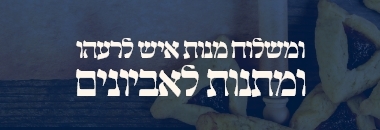Question
When I came to teach one morning I placed a stack of papers on a table in the teachers’ room. By the time I returned in the afternoon to retrieve my papers, a chair had been placed on the edge of the papers. I was in a rush and when I pulled out my papers, the chair toppled over which broke a leg of the chair and a glass vase that was sitting on a nearby shelf. Additionally, a piece of the broken glass flew off to the side and tore a girl’s tights. Am I liable for any of the damages that resulted from my action?
Answer
Since all the damages resulted from your action, the damages fall into the category of odom hamazik – damages that result from human action.
The first issue is whether you are responsible at all since the damages were all unintentional. The Gemara (BK 27B) rules that odom hamazik is liable even for unintentional damages and even if the damage resulted from unforeseen circumstances (oness). Tosafos on that gemara, whose opinion is authoritative, proves that one is liable only for an oness that is “like a loss” (aveidah) and not for extreme unforeseen circumstances (like geneivah). One of his proofs is from the Yerushalmi that rules that a sleeping person is not liable if he damages an object that was placed next to him after he fell asleep, though he is liable if he damages an object that was there when he went to sleep. Another source is the Gemara that rules that a volunteer porter is not liable for breaking a jar that broke because the porter tripped.
In your situation, the fact that a chair that was sitting partially on papers would topple over when the papers were removed could hardly be called unforeseen. Rather, the damage is a result of a mistake in judgment. We find that the Gemara (BK 26B) rules that the one who damaged because of a mistake in judgment is liable. The case discussed in the Gemara is where one intended to throw an object a distance of two amos – where it wouldn’t have caused any damage. But since it actually traveled four amos it damaged a sitting target and the Gemara rules that the one who threw the object is liable for the damages. Thus you are responsible for damages.
Having determined that you are responsible for damages that result from your action, we have to analyze how you damaged each of the objects and determine if that is included in your liability. The damages to the chair are a direct result of your action since effectively what you did was to throw the chair down by picking up your papers. The glass broke because you effectively threw the chair onto it. This way of damaging is called kocho-your strength. You didn’t physically touch the glass but you threw the chair on it and it was due to the force of the flying chair that the glass broke.
We find in a number of cases that the Gemara rules that one is liable for things that broke because someone threw an object at it. For example, the Gemara (BK 4B) writes that one is liable if he spat on a person’s clothes and dirtied them, or ruined someone’s food with his spit. The Gemara calls this kocho. The Gemara writes (BK 22A) that according to some Amoraim (R. Yochonon) that is included in the liability one has for being careless with his fire, which consequently burned someone else’s property. According to this view the Torah views the one who was careless as if he threw fire at the damaged object. Thus, you are liable for the damages to the chair and the vase.
The tights tore because of secondary damage which is known as ko’ach kocho. You threw the chair at the vase and then the flying glass from the broken vase tore the tights. The Gemara never discusses whether a person is liable for damaging by ko’ach kocho. However, the Gemara discusses ko’ach kocho in other contexts and we will try to derive from those contexts how to rule in your situation.
One case that is discussed in the Gemara (BK 19A) is where stones that shot out from under the feet of a walking animal broke an object, whose broken pieces in turn damaged a second object. Sumchos and the Rabbonon dispute whether the owner of the animal must pay the entire value of the first object or only half. The Gemara remains with a question whether Sumchos, who maintains that the owner must pay the full value of the first object, rules that for the second object he only must pay half. The Gemara does not discuss how much the Rabbonon, who maintain that the animal’s owner pays half for the first object, rules concerning the second object.
However, the Rosh (2, 2) comments that from the Gemara’s question concerning how Sumchos would rule, we can derive that the Rabbonon maintain that the animal’s owner must pay half for the second object as well, since it is only due to a special reason that the Gemara has a doubt whether according to Sumchos damages should be reduced. This implies that where this reason is not pertinent one’s liability for secondary damages is the same as his liability for primary damages. The Rosh thus says that the rule is that as far as damages are concerned ko’ach kocho is the same as kocho. We note most importantly that the SA (390, 5) rules like this Rosh without bringing any dissenting opinion.
However there is another place where the SA (392, 1) cites a ruling of the Rambam which seems to contradict this ruling. There is a dispute among the commentaries how to deal with this seeming contradiction. The Sema (392, 3) explains that the second case is not even ko’ach kocho and therefore, there is no contradiction. However, the Gra (390, 13) maintains that there is a contradiction and the SA followed one opinion on one occasion and a different opinion on the second occasion. However, his position is difficult because if one follows his approach Tosafos also contradicts himself.
Thus we have established that among the Rishonim the Rosh maintains that you are fully liable for the tights.
Another case discussed in the Gemara concerns one who kills without intention. The Torah rules that the murderer must go into exile to an ir miklot. The Gemoro (Makos 8A) rules that according to the Rabbonon, whose opinion is authoritative, if a person throws a clod of earth at a date palm causing the date palm to shed a date which fell on someone and killed him, the one who hurled the clod of earth does not need to go into exile.
The Rishonim dispute the reason for his exoneration. The Ritva says the reason is because ko’ach kocho is not the same as kocho. Interestingly, he cites the Gemoro in Bava Kama about Sumchos and the Rabonon that we discussed previously as proof for this ruling, which means that he disagrees with the Rosh that we cited earlier. However, it should be noted that the Rambam (Rotsei’ach 6, 15) explains that the reason the murderer does not need to go into exile is because death from secondary causes is not expected and therefore, the death is classified as an oness for which a murderer need not go into exile. If one understands the Gemara like the Rambam one cannot arrive at a decision concerning monetary damages because the classification of what is considered oness for monetary damages is not the same as the classification when the issue is exile. (For proof see the examples discussed on BK 26B.)
Another situation where the Gemoro discusses this matter concerns intentional murder. The Gemara (Sanhedrin 77B) rules that if a person threw a stone in the air and the stone came directly down without veering to the side at all and killed someone, the one who threw the stone in the air is not executed as a murderer. Tosafos (77A) explains that the reason is because when the stone came down on the victim’s head it was only ko’ach kocho of the one who threw the stone since all the force that was injected by the one who threw the stone was directed directly upwards and had no direct input in the eventual force that brought the stone down on the victim’s head. The stone in its downward trajectory was only ko’ach kocho of the one who threw the stone directly upwards. Since the one who threw the stone only killed by ko’ach kocho he is not liable for murder since one who kills with ko’ach kocho is not executed for his murder.
However, Tosafos and the Tosafos Horosh add that this is a special rule concerning murder and if the stone causes monetary damage the one who hurled the stone is liable. Thus, we have an unequivocal ruling of Tosafos and the Rosh that one who damages monetarily by actions that are classified as ko’ach kocho is liable. This agrees with the ruling of the Rosh in BK that we cited earlier.
Thus, concerning the tights, according to Tosafos and the Rosh and the SA who, according to some, rules this way, you are certainly liable. According to the Ritvo you are not liable. However, there is no proof from the Gemoro that the Ritvo is correct since the Gemara can be understood like the Rambam. If anything, the fact that the Rambam did not explain the Gemoro as the Ritvo did indicates that the Rambam maintains that one is liable for damages that were done by ko’ach kocho.
In conclusion: You should pay for everything you damaged: the chair, the vase and the tights. However, bear in mind that they all were used and you are only liable for their value as used objects.










